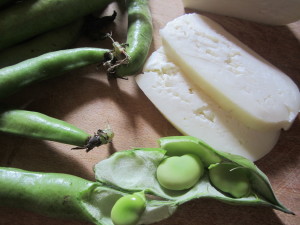 In Italy, many things are done in old-fashioned ways – growing vegetables, caring for animals, cooking traditional dishes – that inevitably tie the people to the seasons. Spring is a time of renewal and many spring dishes reflect the season. Egg-rich dishes and desserts are a result of an abundance of eggs the chickens lay as the days get warmer and longer. Lamb shows up on menus more often, often with fried spring artichokes. In Tuscany, one of my favorite spring pairings is fresh pecorino, or sheep’s milk cheese, and fresh fava beans – cacio e bacelli in Tuscan dialect – that is the perfect example of how the simplicity of a seasonal dish belies the complexity of nature.
In Italy, many things are done in old-fashioned ways – growing vegetables, caring for animals, cooking traditional dishes – that inevitably tie the people to the seasons. Spring is a time of renewal and many spring dishes reflect the season. Egg-rich dishes and desserts are a result of an abundance of eggs the chickens lay as the days get warmer and longer. Lamb shows up on menus more often, often with fried spring artichokes. In Tuscany, one of my favorite spring pairings is fresh pecorino, or sheep’s milk cheese, and fresh fava beans – cacio e bacelli in Tuscan dialect – that is the perfect example of how the simplicity of a seasonal dish belies the complexity of nature.
Most of us are far removed from the farm and little nuances of life tied to the land frequently escape and astound us when we learn of them. In the second year I lived in Italy, it came as a revelation to me that in order for a sheep, or any animal, to give milk, it has to have a baby every year. Tuscany is a big producer of pecorino, or sheep’s milk cheese, and I learned the facts of natural cheese making when my favorite farmer, Fabrizio, closed his dairy in the late autumn. He explained to me, as if I was a small child, that in late summer a ram is put in with the sheep to impregnate them; once the ram’s job is done, he’s put back out to pasture until the next year. (When a Tuscan is up to his ears in work he’ll say “I’m busier than a billy goat in September!”) The pregnant sheep are then slowly weaned off of milking, ending altogether in late October or early November, and the dairy is closed for the winter.
In the late winter, the sheep give birth to little white lambs and it’s another harbinger of spring when you see them frolicking in the fields. As you can’t keep every lamb born, many of them are butchered, and the mammas go to milking again.
In a natural setting, where the farmer allows his animals to live as nature intended, fresh cheese – aged less than 30 days – is available only so long as fresh milk can be obtained. The industrial food complex has developed to give us fresh cheese all year round, the natural process is controlled with hormones and a sheep never even sees a billy goat.
When they begin milking the sheep in the spring, the first cheeses made are fresh pecorino – soft, buttery yellow and aged less than a month. Its arrival is welcome after a long winter of eating only aged cheeses. It coincides with the season of new fava beans. Sold still in their furry pods, they were planted in the fall and have ripened with the spring warmth. Cacio e bacelli, the classic pairing that is a perfect example of Tuscans honoring the seasonings.
At the Italian Table we’ve been thrilled to get our hands on both imported fresh pecorino and cases of fresh fava beans and have been making little baked custards with the cheese and serving them with blanched fava beans and fresh thyme from our herb garden!






